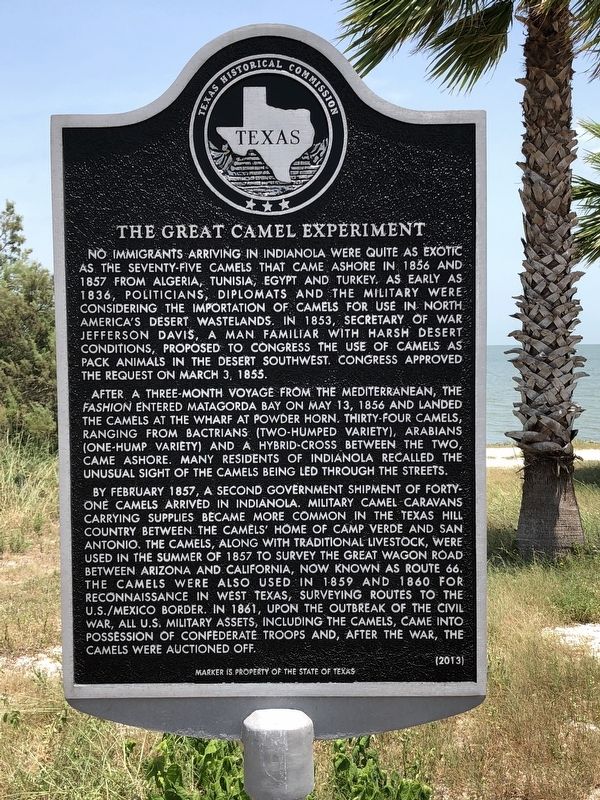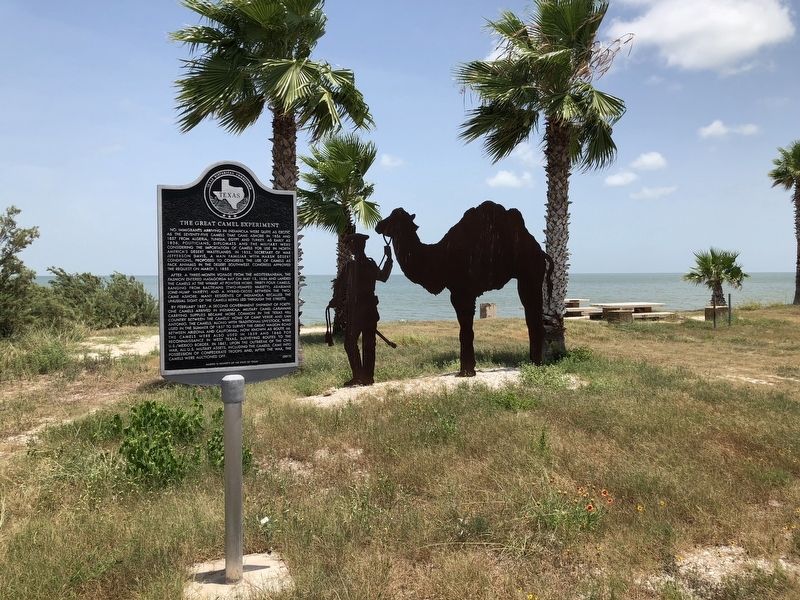Near Indianola in Calhoun County, Texas — The American South (West South Central)
The Great Camel Experiment
After a three-month voyage from the Mediterranean, the Fashion entered Matagorda Bay on May 13, 1856 and landed the camels at the wharf at Powder Horn. Thirty-four camels, ranging from Bactrians (two-humped variety), Arabians (one-hump variety) and a hybrid-cross between the two, came ashore. Many residents of Indianola recalled the unusual sight of the camels being led through the streets.
By February 1857, a second government shipment of forty-one camels arrived in Indianola. Military camel caravans carrying supplies became more common in the Texas Hill Country between the camels’ home of Camp Verde and San Antonio. The camels, along with traditional livestock, were used in the summer of 1857 to survey the great wagon road between Arizona and California, now known as Route 66. The camels were also used in 1859 and 1860 for reconnaissance in west Texas, surveying routes to the U.S./Mexico border. In 1861, upon the outbreak of the Civil War, all U.S. military assets, including the camels, came into possession of Confederate troops and, after the war, the camels were auctioned off.
Erected 2013 by Texas Historical Commission. (Marker Number 17475.)
Topics. This historical marker is listed in these topic lists: Animals • Military. A significant historical date for this entry is May 13, 1856.
Location. 28° 32.075′ N, 96° 30.851′ W. Marker is near Indianola, Texas, in Calhoun County. Marker is at the intersection of North Ocean Drive and State Highway 316, on the right when traveling north on North Ocean Drive. Marker is located in a picnic area near the beach. Touch for map. Marker is in this post office area: Port Lavaca TX 77979, United States of America. Touch for directions.
Other nearby markers. At least 8 other markers are within walking distance of this marker. Mrs. Angelina Bell Peyton Eberly (approx. 0.2 miles away); Indianola (approx. 0.6 miles away); Rene Robert Cavelier Sieur de la Salle (approx. 0.6 miles away); German Immigration Through Karlshafen (approx. 0.8 miles away); Judge Henry Joseph Huck (approx. 0.8 miles away); Old Town Cemetery (approx. 0.8 miles away); The War Between U.S. and Mexico (approx. 0.9 miles away); The German Emigration Company (approx. 0.9 miles away). Touch for a list and map of all markers in Indianola.
Also see . . . Camels - The Handbook of Texas Online. Texas State Historical Association (TSHA) (Submitted on July 23, 2018, by Brian Anderson of Humble, Texas.)
Credits. This page was last revised on July 25, 2018. It was originally submitted on July 23, 2018, by Brian Anderson of Humble, Texas. This page has been viewed 310 times since then and 49 times this year. Photos: 1, 2. submitted on July 23, 2018, by Brian Anderson of Humble, Texas. • Bernard Fisher was the editor who published this page.

